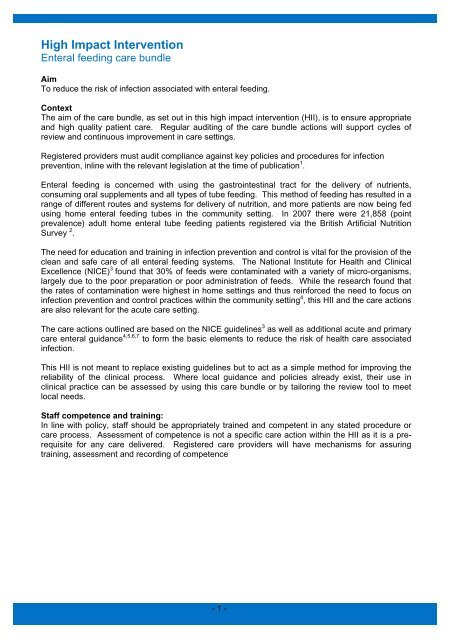Enteral feeding - Nationalarchives.gov.uk
Enteral feeding - Nationalarchives.gov.uk
Enteral feeding - Nationalarchives.gov.uk
You also want an ePaper? Increase the reach of your titles
YUMPU automatically turns print PDFs into web optimized ePapers that Google loves.
High Impact Intervention<br />
<strong>Enteral</strong> <strong>feeding</strong> care bundle<br />
Aim<br />
To reduce the risk of infection associated with enteral <strong>feeding</strong>.<br />
Context<br />
The aim of the care bundle, as set out in this high impact intervention (HII), is to ensure appropriate<br />
and high quality patient care. Regular auditing of the care bundle actions will support cycles of<br />
review and continuous improvement in care settings.<br />
Registered providers must audit compliance against key policies and procedures for infection<br />
prevention, inline with the relevant legislation at the time of publication 1 .<br />
<strong>Enteral</strong> <strong>feeding</strong> is concerned with using the gastrointestinal tract for the delivery of nutrients,<br />
consuming oral supplements and all types of tube <strong>feeding</strong>. This method of <strong>feeding</strong> has resulted in a<br />
range of different routes and systems for delivery of nutrition, and more patients are now being fed<br />
using home enteral <strong>feeding</strong> tubes in the community setting. In 2007 there were 21,858 (point<br />
prevalence) adult home enteral tube <strong>feeding</strong> patients registered via the British Artificial Nutrition<br />
Survey 2 .<br />
The need for education and training in infection prevention and control is vital for the provision of the<br />
clean and safe care of all enteral <strong>feeding</strong> systems. The National Institute for Health and Clinical<br />
Excellence (NICE) 3 found that 30% of feeds were contaminated with a variety of micro-organisms,<br />
largely due to the poor preparation or poor administration of feeds. While the research found that<br />
the rates of contamination were highest in home settings and thus reinforced the need to focus on<br />
infection prevention and control practices within the community setting 4 , this HII and the care actions<br />
are also relevant for the acute care setting.<br />
The care actions outlined are based on the NICE guidelines 3 as well as additional acute and primary<br />
care enteral guidance 4,5,6,7 to form the basic elements to reduce the risk of health care associated<br />
infection.<br />
This HII is not meant to replace existing guidelines but to act as a simple method for improving the<br />
reliability of the clinical process. Where local guidance and policies already exist, their use in<br />
clinical practice can be assessed by using this care bundle or by tailoring the review tool to meet<br />
local needs.<br />
Staff competence and training:<br />
In line with policy, staff should be appropriately trained and competent in any stated procedure or<br />
care process. Assessment of competence is not a specific care action within the HII as it is a prerequisite<br />
for any care delivered. Registered care providers will have mechanisms for assuring<br />
training, assessment and recording of competence<br />
- 1 -
Elements of the Care process<br />
The following actions are outlined as good practice for reducing the risk of infection associated with<br />
enteral nutrition.<br />
Reducing risks of infection associated with enteral nutrition processes<br />
1. Hand hygiene and PPE<br />
Disposable apron worn.<br />
Hands are decontaminated immediately before and after each episode of patient contact using<br />
the correct hand hygiene technique. Use of the WHO ‘5 moments of hand hygiene’.<br />
2. Selection of enteral <strong>feeding</strong> systems<br />
Pre-packaged, ready to use feeds are where possible used in preference to feeds requiring<br />
decanting, reconstitution or dilution 3 .<br />
3. Preparation and storage of feeds<br />
Feeds are stored according to manufactures instructions and where applicable food hygiene<br />
legislation.<br />
A clean working area is prepared and only equipment dedicated for enteral feed are used when<br />
decanting, reconstituting or diluting feeds 3 .<br />
Additions to sterile <strong>feeding</strong> containers are made only when there is no alternative and following<br />
an initial risk assessment.<br />
4. Set up of the enteral <strong>feeding</strong> system<br />
Aseptic technique is used when connecting and flushing enteral <strong>feeding</strong> tubes 3 .<br />
Gloves and apron are worn and disposed off in line with local policy immediately after use.<br />
Line should be labelled and dated and signed and documented in patient records.<br />
5. Hang time<br />
The ‘hang time’ for closed enteral <strong>feeding</strong> systems does not exceed 24 hours /non-sterile<br />
<strong>feeding</strong> systems does not exceed 4 hours 3 .<br />
6. Single patient use equipment<br />
Single patient use equipment is stored clean in a lidded container marked with the patients<br />
name.<br />
Single use equipment is immediately discarded after use 7 .<br />
7. Water flushes<br />
Sterile water is used to flush enteral <strong>feeding</strong> tubes in hospitalised patients, all patients fed via<br />
the jejunum or immuno-compromised patients 6 .<br />
Freshly drawn tap water is used for all other patients.<br />
Single –use syringes or re-usable single patient use syringes used to flush. or reusable syringe<br />
is washed, dried thoroughly and stored in an airtight container until re-use.<br />
Tap water (freshly drawn or boiled water) to be used in non hospitalised patients 6 .<br />
Where used, sterile water bottles are dated when opened and discarded in line with<br />
manufacturers instructions.<br />
- 2 -
8. Stoma site<br />
Sterile stoma dressing techniques are carried out for the first 3 days after initial placement.<br />
After 3 days (if the site is uncomplicated) the stoma site is washed daily with water and dried<br />
thoroughly.<br />
Dressings are used if the gastrostomy site is discharging or the patient chooses to have them 9 .<br />
Using the care bundle and the electronic tool<br />
The use of this care bundle will support cycles of review and continuous improvement, which will<br />
deliver appropriate and high quality patient care.<br />
Audits of compliance to the care bundle should be carried out regularly and the results recorded at<br />
the point of care. They should be carried out by peers and the results can be collected manually or<br />
electronically depending on what is appropriate. The use of an electronic, graphical package such<br />
as the HII electronic tool provided is recommended, as this will increase the understanding and<br />
usefulness of the overall results.<br />
The electronic tool will:<br />
Collect, collate and produce different views of the information.<br />
Clearly identify when actions within the care bundle have or have not been performed.<br />
Provide information to support the development of plans to resolve any issues and improve the<br />
quality of care.<br />
Support a culture of continuous improvement.<br />
Recording and making sense of the results<br />
Print an audit sheet from the HII electronic tool or alternatively create one such as the example<br />
below.<br />
When a care bundle action is performed, insert a Y in the relevant column. If the action is not<br />
performed, insert an X in the relevant column.<br />
When the care action is not performed, as it is not applicable (for example local policy has<br />
determined it as not applicable in all or certain situations) insert an N/A to demonstrate that local<br />
policy is being adhered to. (This is then recognised as a Y when total compliance is been<br />
calculated).<br />
Calculate the totals and compliance levels manually or enter the results into the HII electronic<br />
tool to calculate these for you.<br />
The goal is to perform every appropriate action of care every time it is needed and achieve<br />
100% compliance with the care bundle. The “All actions performed” column should be filled with<br />
a Y when all the appropriate actions have been completed on every required occasion. See the<br />
example below.<br />
Where actions have not been performed, overall compliance will be less than 100%. This<br />
provides immediate feedback for users of the tool on those care bundle actions not completed,<br />
and action can then be taken to improve compliance levels.<br />
- 3 -
Example audit sheet<br />
1<br />
2<br />
3<br />
4<br />
5<br />
Total number of times an<br />
individual action was<br />
compliant<br />
Actions<br />
% when action of care was<br />
given<br />
Care action<br />
1<br />
Care action<br />
2<br />
- 4 -<br />
Care action<br />
3<br />
Care action<br />
4<br />
All actions<br />
Y N Y Y N<br />
Y Y N Y N<br />
Y Y N/A Y Y<br />
Y Y Y N N<br />
Y Y Y Y Y<br />
5<br />
100%<br />
4<br />
80%<br />
This example tool shows that while most care actions were performed, on only two occasions<br />
were ALL actions performed correctly while all actions was only 40% and as a result the risk of<br />
infection was significantly increased. (Please note for observation no 3. the N/A was calculated<br />
as a Y and overall compliance was achieved).<br />
When the information has been entered into the HII electronic tool a compliance graph for each<br />
action of care and for overall compliance to the care bundle can be produced. This will show<br />
where to focus the improvement efforts to achieve full compliance and achieve high quality<br />
patient care.<br />
4<br />
80%<br />
4<br />
80%<br />
2
References:<br />
1 Department of Health. The Health and Social Care Act 2008: Code of Practice on the prevention and<br />
control of infections and related guidance. Department of Health, London, 14 Dec 2010. Available at<br />
http://www.dh.<strong>gov</strong>.<strong>uk</strong>/en/Publicationsandstatistics/Publications/PublicationsPolicyAndGuidance/DH_1226<br />
04<br />
2 BAPEN (2008) Annual BANS Report 2008. Artificial Nutrition Support in the UK 2000-2007. A report by<br />
the British Artificial Nurtrition Survey (BANS), a committee of BAPEN www.bapen.org.<strong>uk</strong><br />
3 National Institute for Clinical Excellence. (2003) Infection control, prevention of healthcare associated<br />
infection in primary and community care - NICE Guideline. London: National Institute for Clinical<br />
Excellence<br />
4 National Collaborating Centre for Acute Care, February 2006. Nutrition support in adults Oral nutrition<br />
support, enteral tube <strong>feeding</strong> and parenteral nutrition.<br />
National Collaborating Centre for Acute Care, London. Available from www.rcseng.ac.<strong>uk</strong><br />
5 National Institute for Clinical Excellence (2006) Quick reference guide. Nutritional Support in Adults. Oral<br />
nutritional support, enteral tube <strong>feeding</strong> and parenteral nutrition. www.nice.org.<strong>uk</strong><br />
6 Infection Control Nurses Association (2003) <strong>Enteral</strong> <strong>feeding</strong> – infection control guidelines www.ips.<strong>uk</strong>.net<br />
7 MHRA DB 2006 (04) Single use medical devices: Implications and consequences of reuse.<br />
http://www.mhra.<strong>gov</strong>.<strong>uk</strong>/Publications/Safetyguidance/DeviceBulletins/CON2024995. (last accessed<br />
18/06/2010<br />
8 Infection Prevention Society (2010) Quality Improvement tools. www.ips.<strong>uk</strong>.net (Documents still awaiting<br />
publication as of 18/06/2010)<br />
- 5 -
















